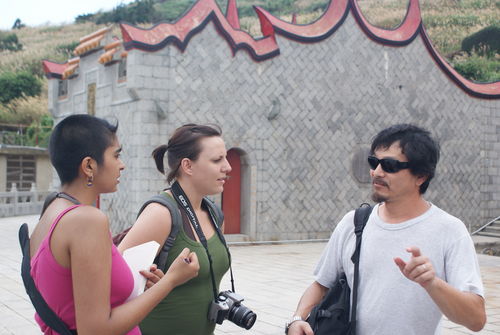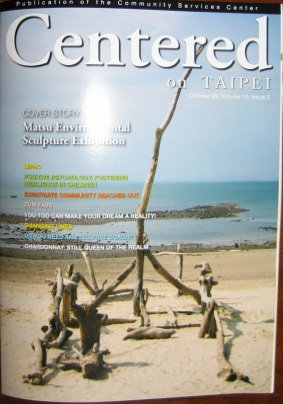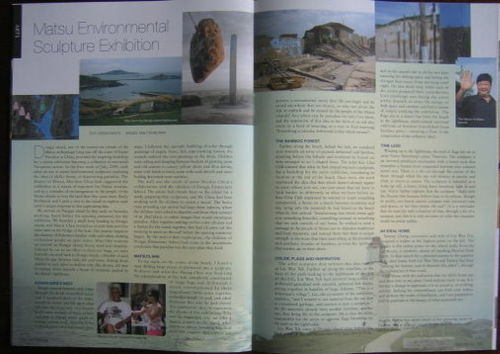張貼者
"Centered on Taipei' 10月封面故事為 --閱讀人次 : 2602 "Centered on Taipei"10月封面故事報導"2009莒光環境藝術季"請連結 htttp://www.community.com.tw/archives.php 內頁22,23
Matsu EnvironmentalSculpture Exhibition
Dongju island, one of the twenty-six islands of the
Matsu archipelago lying just off the coast of Fujian
Province in China, provided the inspiring backdrop
for a recent exhibition featuring a collection of renowned
Taiwanese artists. In the first week of July, 2009, each
artist set out to create environmental sculptures exploring
the idea of idyllic home, of discovering paradise. The
Mayor of Matsu, She-shen Chen had suggested the
exhibition as a means of exposure for Matsu tourism,
and as a reminder of encouragement to the people of the
Matsu islands to love the land that they come from. Emily
McMurrin and I paid a visit to the island to explore each
artist’s unique response to this captivating idea.
We arrived on Nangan island by ship early on Saturday
morning, hours before the opening ceremony for the
exhibition. We boarded a small ferry heading to Dongju
island, and Mayor Chen invited us to join him and five
other men on the bridge of the boat. Our journey began in
the clamour of fishermen familiar with each other, chatting
in betelnut gurgle on open water. After fifty minutes
we arrived on Dongju island, blurry eyed and sleepless.
Ushered by car to an office to drop our bags, we were
hurriedly escorted back to Dongju beach, a thimble of sand
filling the gap between rock, hill and water. Fishing boats
nodded to each other in shallow tide, like drowsy old men
in rocking chairs beneath a breast of mountain peaked by
the island’s lighthouse.
BOWER BIRD’S NEST
People weaved between each other
through the throb of muffled ocean
roar. I wandered down to the water,
turned the corner and fell upon what
felt like the discovery of a bower
bird’s nest: dollops of blue, yellow
and pink in vibrant pastel splash on
a large cement wall, dripping down
a tiered plaza of dilapidated stone
steps. I followed this sporadic bubbling of color through
paintings of angels, boats, fish, pipe-smoking moons, the
animals outlined like cave paintings on the shore. Children
were rolling and dangling between buckets of glowing paint
and old cement in canary yellow shirts and blue denim,
some with brush in hand, some with sand shovels and some
holding decorated stone ocarinas.
The wall was the result of artist Nicolas Chiou’s
collaboration with the children of Dongju Elementary
School. The artists had already been on the island for a
week, preparing their sculptures, and Mr Chiou had been
working with the children to create a mural. The heavy
rains preceding our arrival had kept them indoors, where
the children were asked to describe and draw their concept
of an ideal place, or rather images that would encompass
paradise. After together settling on five color choices and
a format for the mural together, they had all come out this
morning to paint on the wall before the opening ceremony
began. By the end of their exploration, the children of
Dongju Elementary School had come to the unanimous
conclusion that paradise was the very place they lived.
MATSU’S ARK
To my right, on the center of the beach, I found a
man shifting large pieces of driftwood into a sculpture.
Professor and artist Kai Huang Chen was finalising
his representation of the Ark, completely constructed
of large logs and driftwood. I
stood, overshadowed by these
magnificent limbs sewn together,
embedded deeply in sand, and asked
Professor Kai why he had chosen
this particular idea to represent
the theme of the exhibition. Why
not? he responded, why not offer a
legend, a story, to the island, when
history is always inventing historical
sites? Kai suggests that anyone can
OCTOBER 09 22 ARTS
Matsu Environmental
Sculpture Exhibition
TEXT: AYESHA MEHTA IMAGES: EMILY MCMURRIN
Tammy and her husband Lin Wen Teh
View from the Dongju island lighthouse
possess a monumental story; that life can begin and be
saved anywhere that we choose, so why not allow the
Ark to embark and be created by the people of the Matsu
islands? Any place can be paradise for who live there,
and the expression of this idea in the form of an ark also
exists as a kind of meaning, or a way to find meaning;
“Everything is circular, driftwood is that which returns”.
THE BAMBOO FOREST
Further along the beach, behind the Ark, we wandered
over towards an array of painted driftwood and bamboo,
standing before the hillside and bordered by buried car
tires arranged in an L-shaped fence. The artist Kuo Chin
Chih insisted that what he had created was not a sculpture,
but a backdrop for the entire exhibition, considering its
location at the end of the beach. Once more, the work
reinforced the idea that that which doesn’t already appear
to exist where you are, can just mean that we have to
look harder or differently at what we have before us.
Kuo Chin Chih explained he wanted to create something
unexpected, a forest on a beach between mountain and
sea, using only the materials he had found on the beach
when he first arrived. Transforming that which seems ugly
into something beautiful, something unusual or something
that we seek outside of our home, he wished to send a
message to the people of Matsu not to abandon traditional
and local materials, and remind them that there is unique
strength in the stone that their land offers, in the durability
and aesthetic wonder of bamboo, in even the ‘garbage’
that washes up on their shore.
COLOR, FLAGS AND INSPIRATION
The other sculpture that enforces this idea is that
of Lin Wen Teh. Further up along the coastline, at the
base of the path leading to the lighthouse at the top
of the hill, Lin Wen Teh had planted long pieces of
driftwood garnished with colorful, spherical fish buoys,
strung together in bundles of large fishnets. “This is a
fisherman’s village”, Lin, the co-creator of the exhibition
explains, “and I wanted to use material from the sea that
is considered garbage, and convert it into a sculpture.”
As the materials already have another function, another
use, they bring life to the sculpture. He is also the artist
responsible for the series of colorful flags breathing up
the path to the lighthouse.
Lin Wen Teh came to Dongju island twice before this
final week of the exhibition; the first time just to look,
and on the second visit to sit for two days
assessing the shifting space and feeling the
changes that occur from morning until
night. On this third visit, while each of
the artists prepared their contribution,
Lin’s challenge was facing the artist
within himself, to sense the energy of
both space and creation and find a means
of simply unifying the exhibition. The
flags are in a direct line from the beach
to the lighthouse, multi-colored universal
emblems of freedom brandished from
bamboo poles – ensuring a flow in the
composition of the collective ideal.
TIME-LESS
Winding up to the lighthouse, the trail of flags led me to
artist Victor Shteinberg’s piece: Time-less. The sculpture is
an inverted pendulum mechanism with a heavy rock that
resembles a human heart suspended between two concave
metal arcs. There is a slit cut through the center of the
heart, through which the sun will shimmy at sunrise and
slink in return at sunset. The sculpture is intended as a
wake-up call, a heavy, living heart breathing light in and
out. Victor further explains that the sculpture “deals with
the illusion that humans believe time to be infinite, though
in reality, our hearts cannot compete with universal time
and space, or for that matter the sun”. It is a reminder
that we exist for only a fraction of time, through a slit of a
moment, and that it is vital we learn to value this exquisite
world we reside within.
AN IDEAL HOME
Tammy Cheng, co-creator and wife of Lin Wen Teh,
designed a ladder at the highest point on the hill. The
ladder is the tallest piece on the island aside from the
lighthouse, a symbolic means of reaching Heaven from
Earth. In their search for a personal answer to the question
of an ideal home, both Lin Wen Teh and Tammy had been
“looking for heaven, just to discover this place”, through
the exploration of their work.
I left Matsu with the realisation that my idyllic home can
and does exist in any place I look and am ready to see. It is
beyond a change in approach, it is an actuality, an evolving
activity. Seeking the extraordinary can both exist within
and without the realm of familiarity, and I am prepared to
fold in gratitude to the beauty of what surrounds me.
Ayesha Mehta has spent most of her growing years in
Taiwan. She is a vocal coach, writer and an enthusiastic
ukulele player.

Centered on Taipei記者




